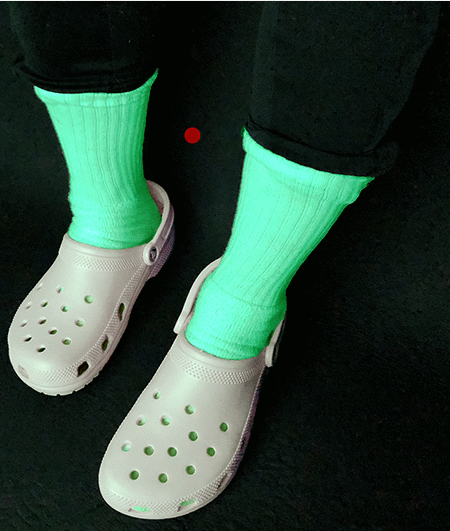Pascal Wallisch & Michael Karlovich
The degree of polarized disagreement about current events is at an all-time high, and rising.
So we need to understand disagreement better in order to avoid disagreeable results.
A key problem when studying discord in politics or economics is that all issues are loaded – people have entrenched positions that might make it hard for them to accept some potential conclusions of such an investigation.
One viable research strategy to circumvent this problem is to explore perceptual disagreements instead. These are arguably sufficiently free of preconceptions – innocent enough – that people are open-minded to the outcomes of such research.
Fortuitously, we were blessed with the dress – an image that evokes vehement disagreement about perception.
However, this image – and others like it – were mostly considered but mere curiosities.
This is a fair point – until now, no one was able to intentionally create such displays, so it was unclear whether the disagreement about the colors of the dress has significance beyond the idiosyncratic quirkiness of that particular image, or if there are wider implications.
We derived a principle underlying the nature of disagreement, which allows us to design perceptually ambiguous displays at will, and – in turn – understand how disagreement comes about in general.
Let’s illustrate this general principle with a specific example, the case of color, and – even more specifically – a particular type of footwear, crocs. We first create uncertainty about the color of the crocs by removing any cues that would be present under typical viewing conditions. We then illuminate the crocs with colored lights so that they appear as some shade of grey. We finally add a second object that has a characteristic color – like a white tube sock – that reflects the color of the lighting, but which could be any color.
This – in turn – creates the disagreement. Some observers will take the appearance of the object at face value and perceive grey crocs, with colored socks. Others will remember that socks like that are usually white and use this subtle cue to calibrate the lighting of the overall display, perceiving pink crocs, as they would appear under normal lighting, and with white socks, see gif.
We call this principle SURFPAD (Substantial Uncertainty combined with Ramified or Forked Priors and Assumptions yields Disagreement). We used it to create several color ambiguous displays of crocs and surveyed a large number of observers about their perceptions.
We found that observers indeed disagree about the color of the crocs and that the way an individual observer perceives the crocs depends on how they interpret the socks. Observers who think the socks are white – despite them objectively appearing colored – are likely to see the crocs as if they were illuminated with natural light (pink), whereas those who see the socks as colored don’t. In turn, the propensity to see the socks as white in the first place was linked to one’s experience with these socks. Finally, we show that the individual perception of the crocs has no bearing on how someone sees the dress, highlighting that croc perception involves a different kind of assumption – assumptions about fabrics, not assumptions about light, like in the dress. Put differently, this is not just a warmed over dress effect – it is superficially similar, but separate and novel.
There are several wider implications of this research. First, as you can see for yourself, the effect is stronger if you focus on the red dot – or on a part of the socks instead of the crocs. This could reflect the fact that the color signal coming from photoreceptors is stronger in the fovea (where there are more cones) than in the periphery. Of course, if you already perceive the crocs as grey even if they are illuminated with green light, they should not change color subjectively.
This brings us to some of the more psychological possibilities one could consider. For instance, most people think they see things how they really are. However, in this case, that presents a conundrum: When presenting displays created with SURFPAD principles to observers, we found that whereas some saw the crocs like the pixels as they really appear on their monitors – grey – others saw the crocs as pink – the color they really are as the manufacturer intended them to appear when viewed under everyday lighting conditions. So does “really” mean “grey”, as an analysis of the pixels with photoshop would yield or does “really” mean “pink”, the color that the manufacturer intended to sell? Related to this is the question of whether someone sees objects in terms of their isolated component elements – the grey pixels – or the colored crocs as wholes in the context of particular lighting. Moreover, this could touch on another personality difference, namely whether someone (perceptually) “lives in the past” – by taking information from prior experience into account more strongly than those who don’t.
What all of these considerations have in common is that they require further research – these tendencies could reflect general personality characteristics, but it is also possible that these individual effects do not transfer to other displays.
As it is, this research does suggest that perception and cognition are more closely intertwined than previously believed, as one’s beliefs can demonstrably color perception. That is important because if cognition plays a large role in perception, it is plausible that perceptual principles in turn underlie cognitive phenomena. Our findings open up a new avenue of research – instead of studying cognition in a siloed fashion (i.e. studying memory completely independently from studying other cognitive functions like attention or perception), as has been the norm, we can now attempt to use perception as a bridgehead to gain traction on more elusive cognitive phenomena.
For instance, it is clear cultural effects play a large role in shaping the human experience. However, culture is extremely hard to study. In contrast, studying culture on a perceptual footing – as a set of shared experiences and assumptions – is much more tractable. Imagine a culture where people wear one kind of garment – say white socks and another culture where they wear black socks. We now have clear predictions as to what people from these cultures would perceive if they were confronted with displays engineered with SURFPAD principles.
But the real value of this principle might lie in a deeper understanding of disagreement about more controversial topics. While we need to study this directly, it is quite conceivable that the same principles that govern perceptual are those that underlie conceptual disagreement. It has been the source of considerable uneasiness that people with unorthodox but dearly held beliefs that are central to their identity (such as anti-vaxxers or flat-earthers) are essentially immune to being convinced of alternative views. Introducing challenging evidence does not change their beliefs. If anything, it strengthens them. This might appear puzzling, but makes complete sense in a SURFPAD framework. Consider the following hypothetical. Imagine that every day, newspapers write an article pointing out that a certain politician is a bad person. Naively, one could think that if the media is doing that, they will paint the figurative socks as really, really green, and readers should be swayed and start to realize that the politician in question is indeed a bad person. And this would work, if people had no preconceptions. But they do. For instance, some people know that the socks are actually white. For those people, seeing really green socks will make them conclude that the lighting is off and just allow them to estimate better just how off it is. And people will have no problem believing that, as they know that anyone can be put in a bad light, and levels of trust in the media are rather low, so people are quite ready to believe that the media would alter the lighting.
Note that in this model, no updating of the prior beliefs takes place, even with repeated exposure, as the socks are still seen as white, the crocs still as colored and the lighting is still discounted, in a cascade of polarized interpretations. If anything, the belief in the color of the socks and the biased light is strengthened.
So what is one to do if one wants to change someone’s mind, particularly about dearly held beliefs?
Our research suggests that simply presenting new evidence is not going to be compelling, as it will be interpreted in light of the pre-existing framework of assumptions. Instead, there are two potentially effective avenues for changing someone’s mind. First, highlighting assumptions directly and questioning why they are made in the first place promises some success. Second, one could address the potential for confusion between sock and light color directly – and offer a more compelling alternative scenario, i.e. pointing out why in this particular situation, it is more likely that the socks are actually green, and that the lighting is still white. Third, maybe we should incentivize a culture that discourages – not encourages – the ramification of priors.
To summarize, it is clear why the brain has to make these assumptions in order to operate effectively in an uncertain world. The necessary information to act is not always available, so it is prudent to make educated guesses. Under normal conditions, this works reasonably well, which is why we are all still here. However, what is nefarious about this is that your brain does not tell you when it quietly jumps to – unwarranted – conclusions by over-applying assumptions, much like autocorrect is often largely aspirational – it isn’t actually correct all that often.
In the area of politics, this is dangerous, as different people will apply different sets of assumptions (or priors), and there are now entire industries dedicated to the ramification of these priors. We have to come to terms with the ongoing and intentional forking and ramification of priors and its deleterious impact on civil discourse in one way or the other if we are to avoid the downside of this process. Given uncertainty and forked priors, disagreement might be inevitable, yet conflict might be avoidable. We suggest to achieve this by bringing about a new culture of disagreement on the basis of SURFPAD principles.
If you want to contribute to a follow-up of this research, you can do so here.



So, what does it mean if I KNOW the socks are white and the crocs are pink, but when the lighting changes the white socks look briefly pink (as if they were washed with red fabric) then become white, but the crocs remain grey no matter what? I can see the red dot and it’s clearly read, but the crocs always look gray to me.
The dot appears red to me as the socks alternate between white and green. The crocks remain grey for me.
3 out of 3 – same for me.
Definitely no pink Crocs, but the retinal negative of the green socks fades from pale magenta to a dull, light grey/white then back to bright green.
The only thing i see altering colour are the socks.
I see the same thing as Ed. Is this an animated gif? It is not explained in the text.
Or rather: I see them alternating between grey and green.